Abstract
Viral pneumonia is a significant cause of morbidity and mortality. This review looks at the clinical features, diagnostics, clinical course, as well as options of treatment of viral infections and associated pneumonias, the necessity of differential diagnostics between viral and bacterial pneumonias. The emergence of such infections as severe acute respiratory syndrome, Middle East respiratory syndrome, and the rise of COVID-19 pandemic have posed new challenges for clinicians in terms of rapid diagnostics and medical care delivery for patients with viral pneumonia. The clinical manifestations of diseases are often indistinguishable from infections of other etiologies, and epidemiological data are necessary for diagnosis. Many researchers report that among clinical features of viral pneumonia, including COVID-19, the risk of developing respiratory distress syndrome and multiple organ failure are noteworthy. Laboratory data show a tendency to lymphocytopenia. Radiological signs include ground-glass opacities, areas of consolidation, often located subpleurally. In addition, potassium loss, as well as predisposition to hypercoagulation with further thrombogenesis are also a concern in COVID-19 patients, and have to be addressed accordingly. Etiotropic therapy options for viral pneumonia, including COVID-19, are scarce today, various medications are being discussed.

